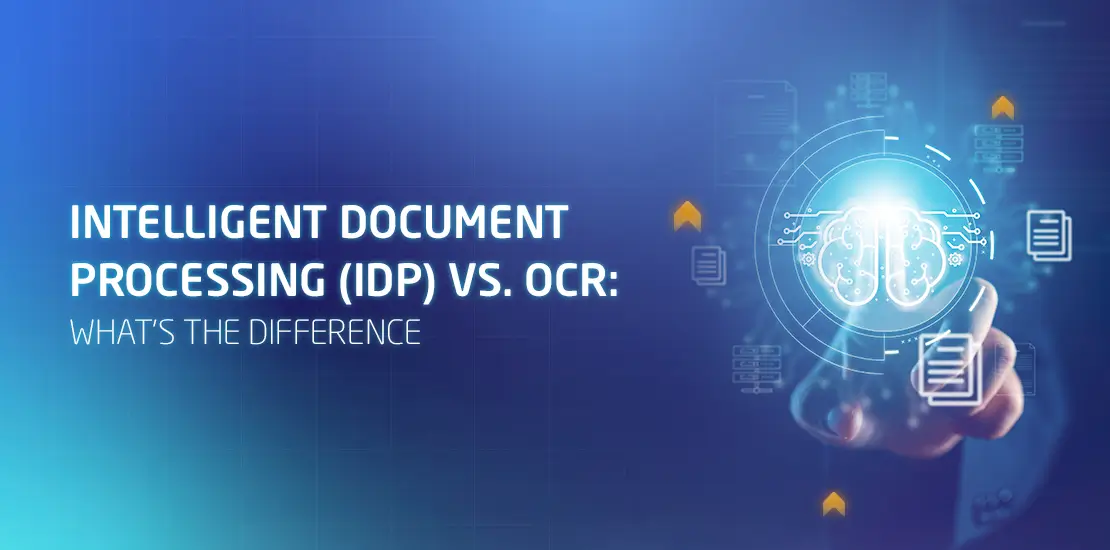
Every business process includes documentation, in which approximately 80% of the data is hidden or trapped. Intelligent document processing is critical to business success because it helps better understand the data and that in return allows you to make better business decisions.
On average, office employees handle over 10,000 document pages annually, with 45% of this material becoming obsolete within a day. Additionally, employees spend approximately 30-40% of their time searching for specific data or documents.
Although these challenges are evident to certain companies, many businesses struggle to effectively digitise their data for seamless accessibility and machine readability. It's important to note that merely scanning a document and converting it to a PDF is not the solution.
Defining OCR and IDP
At its core, Optical Character Recognition (OCR) is a technology that recognises text within images, allowing it to be edited, indexed, or repurposed. For instance, when you scan a physical document and convert it into a searchable PDF, you are utilising OCR.
IDP encompasses a broader set of capabilities, combining OCR with artificial intelligence (AI) and machine learning (ML) techniques. IDP systems can understand, interpret, and process the content within documents, regardless of their format or complexity. It goes beyond mere text recognition, facilitating tasks such as data extraction, categorisation, and validation.
The Evolution
Traditional OCR systems, which emerged in the late 1960s and 1970s, were groundbreaking for their time, allowing businesses to transform reams of paper documents into digital files. However, OCR’s limitations became evident as it struggled with handwriting, varying fonts, or low-quality scans. Errors were common and manual intervention was required.
Intelligent document processing (IDP) emerged as the next step in document processing evolution. Leveraging advanced AI and ML algorithms, IDP systems can learn from mistakes, improving accuracy over time.
While OCR is mainly about converting images to text, IDP extends to understanding and processing the content, structure, and intent of documents. It can handle structured, semi-structured, and unstructured documents.
Intelligent Document Processing Solutions Use Cases
IDP can be implemented in different businesses for different purposes. Here are some ideas to get the best out of IDP in your business.
Extraction of Data in the Health and Pharmaceutical Sectors
Intelligent document processing plays a vital role in the healthcare sector, as it automates data extraction from any complex document in seconds such as patient leaflets, batch records, scientific articles, study reports, safety data sheets, certificates, contracts, patient information and more. It is designed to understand documents as a human does, and extracts text, pictures, structures, tables, and more.
Accelerated Data Retrieval from Payslips
Financial institutions must swiftly and accurately perform applicant background checks, particularly in extracting payslip data for prompt customer notifications. Unfortunately, current payslip data extraction processes often involve time-consuming manual data entry by bank personnel, causing workflow disruptions and customer frustration. This new technology can revolutionise these processes, automating payslip data extraction, freeing up staff for higher-value tasks, and enhancing the customer experience.
Managing Contracts
Intelligent document processing enables expedited and precise contract analysis. Through data extraction, you can instantly access generic contract information such as type, duration, and the product sold, as well as delve into more specific details like unique contractual clauses and general contractual specifics with a single click.
Process Orders in Real Time
The world of money never sleeps. This is one of the reasons why you need to process incoming orders as quickly and accurately as possible. Implementing this powerful tool enables rapid response to purchase orders in real time. Even the smallest order can generate a huge amount of documentation. Thanks to intelligent document processing, you'll always know what's happening, never miss inventory, and strengthen customer relationships through faster response times.
IDP in this case helps you process documents such as quantity purchased, product/service purchased, price per unit, names, model, numbers, delivery date location, and billing address.
Invoice Processing
Manually managing large numbers of invoices can lead to missing or duplicate invoices, which can result in some customers being overcharged. Additionally, invoices may take longer to reach customers, which can result in delayed payments on your books.
IDP can help you avoid such mishaps and free your employees from stressful and tedious manual data entry.
Looking for a cutting edge IDP solution? Contact EDC today to request a demo.



